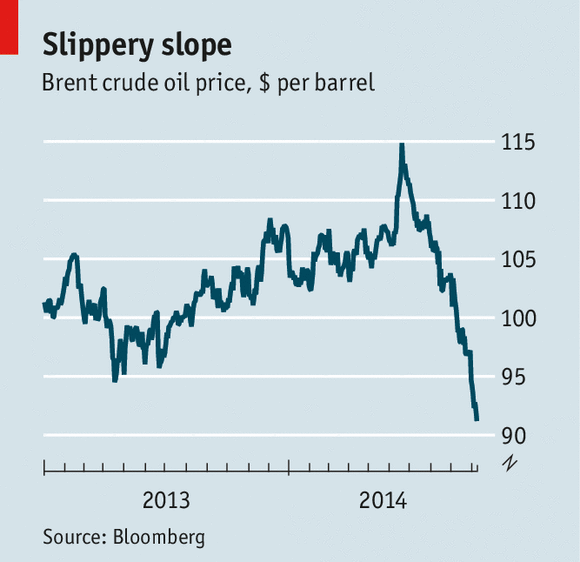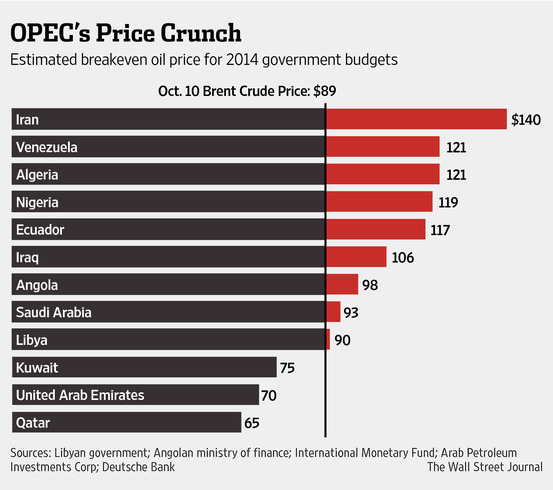Oil has now become another front in the competition between America’s friends and enemies in the Middle East. On October 1st Saudi Arabia, the OPEC cartel’s dominant producer, pumping around a third of OPEC’s oil, or about 9.7 million barrels a day, unilaterally cut its official prices. The Economist reports on the surprising price of oil:
Since June the price of a barrel of Brent crude oil—the global benchmark—has slumped from $115 to $92, a decline of 20%, and the lowest for more than two years.
Here is the Economist’s graph of Brent crude prices:
They report that the drop is partly due to economic weakness. Growth is slowing, particularly in China and the Euro zone, bringing with it a reduction of oil consumption. The WaPo reports that prices have fallen in the US as well: (brackets by the Wrongologist)
Crude oil prices are…down to the lowest level in 17 months in the US. Gasoline prices have [also] been sliding.
Reuters reports that Saudi Arabia told the oil market it would be comfortable with prices as low as $80/barrel for a period of up to two years. Reuters says the following about the Saudi strategy: (emphasis by the Wrongologist)
The Saudis appear to be betting lower prices – which could strain the finances of some members of OPEC – will be necessary to pave the way for higher revenue in the medium term, by curbing new investment and further increases in supply from places like the US shale patch…
This drop in prices will give a short-term boost to the US economy and US consumers, who will view cheaper gas prices like an increase in take-home pay. But it could put a dent in revenues in countries such as Russia, and Iran, where oil exports play an enormously important role in supporting economic growth and government finances. Russia’s Finance Minister has already announced that lower oil revenues could force the curtailment of its military spending:
Between 2004 and 2014, Russia doubled its military spending and according to the newly adopted budget, it will further increase it from 17.6 percent of all budget spending this year to 20.8 percent, or 3.36 trillion rubles ($84.19 billion), in 2017.
But the new Russian budget, which envisages a deficit of 0.6% of GDP over the next three years, is based on oil prices of $100+ per barrel, not the high-$80’s seen this week. On Monday, President Putin signed a law that would allow the government to tap one of the country’s oil windfall revenue funds, the Reserve Fund, for the first time since the aftermath of the 2007-8 global financial crisis. The Fund contains $90 billion. While it is doubtful that this will change Russia’s stance on Ukraine, it might influence Russia’s position on Syria.
The Wall Street Journal reports that Iran has a higher per barrel break-even price than other Middle East oil producers. Here is the oil per barrel price required to balance each country’s budget:
Iran, faced with lower oil revenues and the highest break-even price, could be forced to limit its nuclear program, or even its support for Iraq’s battle against ISIS.
But before we have a party and celebrate, lower prices also affect oil production in the US. The Economist quotes David Vaucher, an analyst at IHS, who says that to achieve a realistic internal rate of return on investment of 10%, a typical new shale-oil project in America requires an oil price of $57 a barrel, but some still require between $75 and $110.
The Obama administration held detailed discussions in September with the Kingdom of Saudi Arabia. While it was clear that one outcome was an agreement by the Saudis to participate in air attacks on ISIS, it is clearly possible that the plan to use oil prices as a tool in the fight was also on the table. It wouldn’t be the first time that oil price (or availability) has been used as a weapon. Oil was first used as a weapon by the US to stop Israel, Britain, and France from retaking the Suez Canal in 1956.
And as Michael Klare says at Oilprice.com, the “oil weapon” was used in 1973 against the US. We hated OPEC’s war on our economy back then. Skip ahead four decades, and it’s smart, it’s effective, and it’s the American way. We of course, used that very same old oil weapon when we embargoed oil sales by Saddam Hussein’s Iraq.
Oil is again the centerpiece of our Middle East strategy.



Is it any surprise that oil is center stage in the Middle East? They have nothing else to offer. Wait…I forgot about the olives. While the prices are down and the economy can breath, perhaps we should reconsider our stance on expanding our own production capabilities.